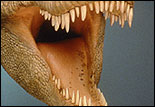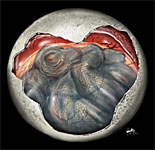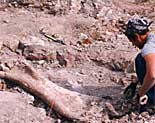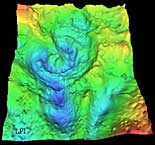2001
News Stories:
 Sue:
Rediscovered Sue:
Rediscovered
A broken leg.
A broken arm. Two broken ribs. Deformed back bones and jaw lesions. Sounds
like a recipe for one very grumpy T. rex.
In fact, the most famous of all
Tyrannosaurs, "Sue," suffered from all these ailments-and apparently
survived them as well. [MORE]
October
News
The
Crocodile That Hunted Dinosaurs
10/31 Paleontologists have announced the finding of a
skeleton of a super- crocodile called Sarcosuchus imperator.
The big croc, estimated to have been around 40
feet long, was found in Africa by Paul Sereno of the
University of Chicago. [Science
UniSci]
Neanderthals
May Have Assisted Debilitated Kin
10/15 From cave rocks in France dating to the middle of the ice
age comes evidence Neanderthals were caregivers to those who
couldn't provide for themselves. A new paper describes a diseased
jawbone devoid of teeth- teeth all but required for survival in
the ancient Neanderthal world. The researchers suggest other
Neanderthals probably brought food to the debilitated individual,
possibly even preparing the food for easy swallowing. [PNAS]
Sauropod Bones From Largest Australian Dinosaur
10/12 Paleontologists recently unearthed a large femur and other
bones from a long- necked dinosaur. The skeleton is believed to be
about the size of an Apatosaurus. [More: Yahoo]
New
Fossil Shows Evolution From Land to Water
10/12 An almost complete skeleton of a new and different permanently
aquatic mammal is described in this week's Nature. This sirenian
(a member of the group that includes manatees and dugongs) had a
back and legs that would have supported its weight to walk on land,
but it probably spent most of its time in the water.
It
thus illustrates the evolutionary transition between terrestrial and
aquatic life. It is, says D. P. Domning of Howard University,
Washington DC, "one of the most marked examples of
morphological evolution in the vertebrate fossil record".
[Source: Nature]

Study: Dinosaur Era a Period of Intense Global Warming
10/7 Recent evidence for high worldwide carbon dioxide levels
some 70 million years ago suggests the Cretaceous Period was an
increasingly hot one. Scientists studied the chemical properties of
fossilized plankton shells and found a notable difference in
readings between those of the Late Cretaceous and others from the
later Tertiary, the period of time that came after the extinction of
the dinosaurs. [UniSci]
Image courtesy ISAS/NASA
 Dinosaur
Embryos Provide First Look at Titanosaur Skulls Dinosaur
Embryos Provide First Look at Titanosaur Skulls
10/5 Nature proved her sense of irony when she revealed
the cranial anatomy of the largest of all known dinosaurs-the
Titanosaurs-in the minute and fragile bones of their embryos.
[More]
Illustration
by Steve Melendrez
Beaked
Dinosaurs Were Filter Feeders
10/3
"Dinosaurs with beaks used their mouthparts as sieves, not
daggers, say researchers. Analysis of unusually well preserved
fossils reveals structures
similar to those used by ducks for filtering food out of the
water, suggesting that they ate small plants and invertebrates
rather than hunted
meat.
Mark
Norell of the American Museum of Natural History, New York,
and colleagues, studied specimens of two species of ostrich
dinosaurs, Ornithomimus edmontonicus from the Canadian
Rockies and Gallimimus bullatus from Mongolia,
where some soft tissues had been fossilized. Many small projections
stick out from the inside of the bill, forming a filter-like
apparatus. If these 'ornithomimid' dinosaurs did feed this way. it
may explain why their fossils are usually found in wet
environments." [Nature]
September
News

50 Million-Year-Old Whale Ancestors
9/26 Researchers recently have discovered two skeletons which
appear to be predecessors of living whales and support the theory
that whales evolved from hoofed mammals. The skeletons- and
several other finds of early whales- were uncovered in Pakistan.
[More: BBC]
Illustration by Carl
Buell
August
News
Feathered
Dromaeosaur Completes Picture of Bird Evolution
8/17 The American Museum of Natural History announced a new
fossil dinosaur from China that confirms again the relationship of
birds and their scaly kin. The specimen is preserved in two halves
and in great detail. Feathers can be clearly seen on the fossil
which otherwise resembles a dromaeosaur- the family of dinosaurs
which includes Velociraptor. [More: AMNH]
Oldest Crustacean Lends Support to Early Evolution
8/17
A tiny fossil related to modern lobsters and shrimps may have huge
implications for the history of life. Advanced forms of life appear
in the Cambrian Period, some 550 million years ago. Researchers have
traditionally thought this indicated a relatively rapid evolution of
animal forms. Recently others have suggested evolution was happening
behind the scenes during earlier times but is not well recorded in
fossils. The new crustacean- an advanced form dated at 511 million
years- tends to bolster the latter theory. [More: BBC]
Finally,
a Complete Titanosaur Skeleton
8/17
One of the most prolific groups of sauropod (long necked) dinosaurs
is among the least studied. This is in part because Titanosaur
skeletons have rarely been found intact and invariably without
skulls. Now a member of the great Cretaceaous long-necks has been
found in Madagascar- and this specimen is nearly complete from
head to toe. [Reported in Nature]
July
News
Skeleton
and Rare T. rex Skin Impressions Reportedly Found
7/25 Paul Sereno of the University of Chicago has described a
skeleton from a large predatory dinosaur spotted near the border of
South Dakota and Nebraska. A source quoted Sereno as saying he
suspects skin may be preserved with the big Jurassic predators
remains. We'll post more information as it becomes available.
Wobbling Mercury Doomed the Dinos?
 7/20 University of California researchers recently discovered
the earth was sent into an uneven orbit around the time of the
dinosaur extinction. The earth's gravitational pull then forced the
planet Mercury into an unnatural orbit. The scientists speculate
these "wobbling" orbits might have had the power to draw
an asteroid out of the asteroid belt and into a collision course
with Earth. [More: CNN] 7/20 University of California researchers recently discovered
the earth was sent into an uneven orbit around the time of the
dinosaur extinction. The earth's gravitational pull then forced the
planet Mercury into an unnatural orbit. The scientists speculate
these "wobbling" orbits might have had the power to draw
an asteroid out of the asteroid belt and into a collision course
with Earth. [More: CNN]
Photo: NASA
New
Dinosaur Egg Site in Patagonia
7/09 "Miners in Argentina's southern region of Patagonia have
stumbled on two nests, each about five feet wide, filled with
fossilized 70 million-year-old dinosaur eggs, museum officials said
on Tuesday." [Source: Yahoo]
June
News
"Sloth-Like"
Theropod One of Two New Dinosaurs from New Mexico
6/20 Named Nothronychus, this newly announced fossil find
is related to a feathered dinosaur in China. It's claws were
exceptionally long and probably used to gather plants-a unique trait for
theropod dinosaurs, most of which were meat eaters. [More: Yahoo]
Nothronychus
was a therizinosaur, a group of dinosaurs not previously known in
the Americas.
Mass
Extinctions Pinned on Ice Age Hunters
6/14 Incriminating new evidence from Australia and North America
points to Homo sapiens as the culprit behind the mass
extinctions of many species of big, exotic mammals and flightless
birds in the late Pleistocene era, 11,000 to 50,000 years ago. If
findings reported [in the latest] issue of Science are confirmed,
humans are guilty of two counts of serial mass murder, 35,000 years
apart, and rival suspects such as climate change are off the hook.
[Source: Science]
Found:
The First Food Grinder
6/7 This week, researchers describe the oldest known vertebrate to
possess the specialized hardware needed to digest plants. Suminia
getmanovi, a newly discovered reptile that lived about 245
million years ago in what is now Russia had close-packed teeth which
would have been ideal for grinding up vegetation. The success of
animals like Sumina would have been good news for predators, leading
to the evolution of the type of ecosystems and food webs with which
we are familiar today. [Source: Nature.
See also CNN]
A
T. rex for New Mexico
6/5
In late 1998, field crews excavated a new T. rex specimen
from New Mexico badlands. The skeleton is now in a lab at the New
Mexico Museum of Natural History and Science. Learn more about the
dig and the ongoing preparation at the BLMs
paleontology site.
Finding
The Lost Dinosaurs of Egypt
 6/3 In 1909 German paleontologist Ernst von Stromer discovered a
treasure of new dinosaur skeletons at the Bahariya Oasis in the
middle of Egypt's Sahara Desert. Shipped to a German museum, the
fossils were completely destroyed during World War II by an Allied
bombing raid on Munich. But the dinosaurs would not be lost forever.
For the last two years, American scientists have been digging in
Bahariva, uncovering more bones from Stromer's famed dinosaurs.
Among the finds is Paralititan Stromeri, the largest dinosaur
ever discovered in Africa. 6/3 In 1909 German paleontologist Ernst von Stromer discovered a
treasure of new dinosaur skeletons at the Bahariya Oasis in the
middle of Egypt's Sahara Desert. Shipped to a German museum, the
fossils were completely destroyed during World War II by an Allied
bombing raid on Munich. But the dinosaurs would not be lost forever.
For the last two years, American scientists have been digging in
Bahariva, uncovering more bones from Stromer's famed dinosaurs.
Among the finds is Paralititan Stromeri, the largest dinosaur
ever discovered in Africa.
[Egypt
Dinosaurs Science]
Photo:
Joshua
B. Smith/University of Pennsylvania
Battle
of the Meat-Eaters: Neanderthal vs. Human
6/1 The saying "you are what you eat" became a reality
for ancient man in Europe. Now scientists have turned up clues to
his diet in 20,000 - year - old bones of Neanderthals. The research
suggests Neanderthal preferred big-game like Mammoth almost
exclusively. Early Humans may have had a wider, but still meat -
centric diet including fish and fowl. [Source: PNAS]
May
News
Half-Size
Tyrannosaur Ancestor From Britain
5/20 A newly discovered predatory dinosaur, named Eotyrannus
lengi has been suggested as a probable predecessor to Tyrannosaurus
rex. Only 15' long-just less than half the length of the
biggest T. rex specimens-this smaller predator lived some 50
million years before T. rex in the early Cretaceous period. [More: Nando]
Sauropod
Dinosaur Goes Airborne
5/16 Big Bend National Park confirms that everything is bigger
in Texas with the discovery of perhaps the largest known long-necked
dinosaur. Last week, ten neck vertebrae weighing up to a half-ton
each where airlifted by helicopter to the Dallas Museum of Natural History. Over
the next couple of years, the museum hopes to prepare and study the
giant bones, believed to belong to an Alamosaurus dinosaur.
[More: National
Park Service]
April
News
Feathered
Dinosaur Spreads its Wings
4/29 Fossils of "feathered" dinosaurs that promise to shed
light on the origin of birds are becoming more common but, like most
fossil skeletons, these dinosaurs are rarely complete, and the bones
are often fragmentary and disarticulated.
This makes the feathered dinosaur described... by Mark Norell of the
American Museum of Natural History, New York, and colleagues all the
more special. The 126-147-million-year-old Chinese fossil is a
complete skeleton preserved spread- eagled on a slab, allowing the
examination of feather- like filaments over the body in
unprecedented detail. [Source: Nature]
Dinosaur
Vomit?
4/17 Paleontologists have found a collection of pellets of
fossilized juvenile bones from different birds that show signs of
having been digested. Based on the size of the pellet and the degree
of digestion, the researchers
suggest that the birds were eaten by a small theropod dinosaur or a
pterosaur, which coughed up the indigestible parts much as
owls do today. [More: Nature]
March
News
"Flat-Faced
Man" Fossil Skull Wrinkles Picture of Human Evolution
3/21/2001
Hot on the heels of the Kenyan fossil Orrorin tugenensis, claimed to
take the human lineage back to around 6 million years ago, comes a
spectacular new find from Meave Leakey of the National Museums of
Kenya and colleagues, described in this week's Nature. At 3.5
million years old, the new discovery threatens to blur the already
murky picture of man's evolution.
The
find is a battered but almost complete skull and face of an entirely
new breed of early human, and is the oldest reasonably complete
cranium known for any member of the human family. The researchers
call it Kenyanthropus platyops - the Flat-Faced Man of Kenya. It
comes from a rugged, semi-desert site on the western shore of Lake
Turkana in northern Kenya.
The
most striking thing about this face is how human it looks. It seems
very similar to the skull KNM-ER 1470, discovered in the 1970s by
Richard Leakey and colleagues on the eastern shore of Lake Turkana.
"It seems that between 3.5 and 2 million years ago there were
several human-like species, which were well adapted to life in
different environments, although in ways that we have yet to
appreciate fully," Daniel E. Lieberman of the George Washington
University, Washington DC, says in an accompanying News and Views
article. [Nature
Press Release]
Virtual Fossils
3/21/2001
A remarkably preserved assemblage of fossils from the Silurian (Wenlock
Series) of Herefordshire, UK, covers a 100-million-year interval,
around 425 million years ago, from which few soft-bodied animals
are known. The relatively deep-water marine environment
represented is dominated by new arthropods and polychaetes. The
fossils are preserved as hollow spaces in volcanic materials, so
the only way to 'see' them is by reconstructing them digitally.
Using techniques more familiar to neuroscience, Mark D. Sutton of
the University of Oxford, UK, and colleagues have reconstructed a
three-dimensional fossil of Acaenoplax - perhaps the earliest
known aplacophoran mollusc - which they present in this week's
Nature. The digital fossil reveals a marked degree of repetition,
throwing light on the controversial question of body segmentation
in primitive molluscs. Movies showing the virtual fossil from all
angles will be downloadable from http://www.nature.com.
[Nature Press
Release]
Dinosaur Extinction Followed by Quick Recovery
 3/15/2001
By measuring levels of an extraterrestrial element in rock
layers marking the end of the Cretaceous Period, researchers found
evidence showing the earth's ecosystems quickly rebounded from the
destruction. The element, helium-3, appears suddenly, persists
at a constant level, then just as quickly vanishes from the rocks.
This finding supports the idea that a single asteroid- and not
comets or volcanoes- was responsible for the great extinction of animal
life including dinosaurs at the end of the Mesozoic Era. [Science
BBC]
Image of Chicxulub crater thought to have been
the point of impact. LPI/NASA 3/15/2001
By measuring levels of an extraterrestrial element in rock
layers marking the end of the Cretaceous Period, researchers found
evidence showing the earth's ecosystems quickly rebounded from the
destruction. The element, helium-3, appears suddenly, persists
at a constant level, then just as quickly vanishes from the rocks.
This finding supports the idea that a single asteroid- and not
comets or volcanoes- was responsible for the great extinction of animal
life including dinosaurs at the end of the Mesozoic Era. [Science
BBC]
Image of Chicxulub crater thought to have been
the point of impact. LPI/NASA
Hype No Longer: Those Dinosaurs Had Feathers!
3/8/2001
Archaeopteryx,
the earliest known bird, came equipped with feathers
indistinguishable from those of any modern bird. This fact has
confounded attempts to reconstruct the evolutionary origins of
feathers. If feathers had morphological antecedents, how would we
recognize them if we found them? If we did find them, how would we
tell that they were feathers rather than some other structure? Enter
the strange, not-quite-hairlike, not-quite-featherlike integumentary
structures of the 'feathered dinosaurs' from China. Proponents of
the theory that birds and dinosaurs are close relatives see these
structures as proto-feathers, but opponents have questioned this
interpretation.
This
week Richard O. Prum of the University of Kansas, Lawrence, Kansas,
and colleagues re-examine the integumentary structures in the
theropod dinosaur Sinornithosaurus millenii, showing that these
appendages are compound structures composed of multiple filaments.
In addition, these structures show two types of branching structure
seen nowhere else but in bird feathers: filaments joined in a basal
tuft, and filaments joined at their bases in a series along a
central filament. These observations corroborate the identification
of these structures as akin to feathers. [Nature
Press Release]
February
News
Dinosaur With a Hatchet-Like Bite?
2/26/2001
Cutting-edge
engineering meets another kind of cutting edge - the teeth of a
Jurassic predator - this week. Emily Rayfield of the University of
Cambridge, UK, and colleagues show that the strong, light skull of
the predatory dinosaur Allosaurus fragilis could withstand a great
deal of stress, even though it could not inflict a bite as
bone-crushing as has been suggested for the larger Tyrannosaurus
rex of the later Cretaceous period. This apparent paradox could be
explained by dinosaur lifestyle. During attack and feeding,
Allosaurus would hit its prey head-on at high velocity, like a
person wielding a hatchet, the researchers suggest. Once in
contact, the animal would tear chunks of flesh out of its prey.
This slash-'n'-slice technique is seen today in a giant lizard,
the Komodo 'dragon' (Varanus komodoensis).
The researchers think
that the skull of T. rex, in contrast, might have been built for
dismemberment rather than high-velocity attack. Rayfield's group
modelled the Allosaurus skull with 'finite-element analysis',
which engineers use to model the distribution of stresses in
structures such as bridges. [Nature
Press Release]
New South American Fossil Mother Lode
2/15/2001
Four new species of dinosaur, an ancient mammal and many reptile
fossils have recently been uncovered at a new fossil site in
Argentina. Scientists say they've only brushed the surface of what
appears to be a vast collection of fossils from the rarely preserved
Middle Jurassic period. [More: Yahoo!]
Pew! Dinosaur B.O. Stinks Up London Museum
2/13/2001 For a new T. rex exhibit, England's Natural History Museum
commissioned a company to recreate a smell associated with
dinosaurs. In the end, they chickened out of a full-blown T. rex
smell: "The most putrid, foulest thing that ever lived."
[More: Yahoo!]
Finally: First maps of Human Genome to be published this week
2/12/2001
The Journals Science and Nature will this week for the first
time will publish research analyzing the 30,000 or so genes in human
DNA. [More: Nature
Science]
BBC Dinosaurs Tromping Back to the Small Screen
2/9/2001
Computer animated dinosaurs seen in the popular BBC series
"Walking With Dinosaurs" will be seen again in a new TV
series. This time the presentation is a live-action drama- a
remake of Arthur Conan Doyle's "The Lost World." [More: CNN]
January
News
Rockin' Name for a Dinosaur
1/29/2001 A dinosaur newly described from Madagascar
was named after rock singer Mark Knopfler. More novel than it's
name, however, is the new predatory dinosaur's teeth. The front
teeth on the bottom jaw point
almost directly outward, a feature not found in any other
known dinosaur. [More: CNN
Nature]
New Evidence from China Suggests Molars Evolved Twice
1/18/2001 A recent issue of the science journal Nature details new mammal
fossil finds that seem to show molars- a feature of all mammals-
evolved twice some 160 million
years ago. [Nature]
Study Supports Multi-Regional Origin of Homo Sapiens
1/14/2001 A recent DNA survey of fossil human skeletons from Australia turned
up a modern human unrelated to other ancient Australians. This
finding is said to dispute the popular theory that modern humans
evolved once in Africa and migrated around the world. [Proceedings
of the National Academy of Science]
2000
News Stories
See
PrehistoricPlanet.com Home Page for Latest News |



